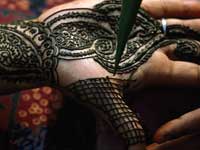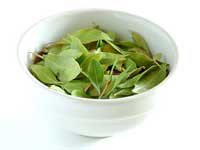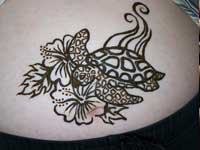»About Henna
 Madonna has done it, Liz Tyler has got it, and more and more westerners are embracing it & you always use to think it was only a marriage ritual in India !.
Madonna has done it, Liz Tyler has got it, and more and more westerners are embracing it & you always use to think it was only a marriage ritual in India !.
Henna is a Persian word, which describes a small flowering shrub (Lawsonia inermis). It is found all over the world, including India, Yemen, Iran, Pakistan, Morocco, Afghanistan, Somalia, Sudan, Libya, Egypt and Bangladesh. However, the variety of henna plant varies from region to region. Different henna plants have different coloring properties and hence, the powder color also varies. Henna has been used for thousands of years, for its medicinal properties and cosmetic properties. Henna is also used for coloring & conditioning of the hair and in the form of body art.
Henna has, today, become a part of all major festivals & celebrations. Be it, Wedding ceremony, Purim, Eid, Diwali, Karwa Chauth, Nowruz or Mawlid, it has graced every occasion with its presence. Celebrations like wedding, birth of a baby and birthdays seem to be incomplete without the ceremony of henna. Brides, in the present time, typically have the most complex patterns of henna, to express their greatest joy and wishes for luck. With an enhanced technology being used for its cultivation, henna available now days, has an enhanced dye content and greater artistic potential than earlier times.
Henna powder, in its pure and natural powder form, is a bright or deep green, or brown. The color produced by pure natural henna ranges from orange to red, to black cherry and near black color. Contrary to the popular belief, pure black color is not produced by natural henna powder. Talking about its production, henna powder is made from the leaves of the henna bushes. When manufactured in large quantities, the henna leaves are taken to the production unit and machine grounded. Normally, henna powder is made by blending different types of henna leaves from different parts of a country or from different countries.
 Once the leaves have been grounded, the powder is sifted. This is because, if not sifted, the henna powder will include pieces of the leaves. The finely sifted henna powder contains no leaves, making it best for cosmetic use. Henna powder colors the skin, when the dye is released, as a result of the henna powder being mixed with lemon juice or even water and being applied on the skin (specially Palm) . Henna, when applied to the body parts such as hands, arms, feet, near the naval region and at the back, is called mehandi. For a simple mehndi design, it may take about 10 to 15 minutes, but if you want to go for an intricate design, you might need to put several hours before removing it completely.
Once the leaves have been grounded, the powder is sifted. This is because, if not sifted, the henna powder will include pieces of the leaves. The finely sifted henna powder contains no leaves, making it best for cosmetic use. Henna powder colors the skin, when the dye is released, as a result of the henna powder being mixed with lemon juice or even water and being applied on the skin (specially Palm) . Henna, when applied to the body parts such as hands, arms, feet, near the naval region and at the back, is called mehandi. For a simple mehndi design, it may take about 10 to 15 minutes, but if you want to go for an intricate design, you might need to put several hours before removing it completely.
 After application of henna (mehndi), you need to dab it, with a lemon-sugar solution when it becomes firm on the skin. This is essentially done to preserve the paste. Unlike tattooing and piercing, henna is painless, because it is applied on the surface of the skin with an applicator (henna cone or henna tube) and not injected into the skin. Conventionally, a henna cone is used for making the designs. However, mehndi can also be made using a bottle, with a fine silver nozzle tip. People enjoy the cooling sensation felt after the application of henna. This aromatic mixture, apart from conditioning the skin, gives a natural soothing effect.
After application of henna (mehndi), you need to dab it, with a lemon-sugar solution when it becomes firm on the skin. This is essentially done to preserve the paste. Unlike tattooing and piercing, henna is painless, because it is applied on the surface of the skin with an applicator (henna cone or henna tube) and not injected into the skin. Conventionally, a henna cone is used for making the designs. However, mehndi can also be made using a bottle, with a fine silver nozzle tip. People enjoy the cooling sensation felt after the application of henna. This aromatic mixture, apart from conditioning the skin, gives a natural soothing effect.
Henna Body Painting
Henna body art has been in trend, since times immemorial. Right from piercing, tattooing to body painting, there are a number of options for people to enhance their look with the use of henna art.
Henna Paste
For henna powder to release the dye you will have to make a paste of the henna powder by mixing water or lemon juice in it. There are a number of things that can be added to the henna powder to make a paste that will stain your skin or hair the color you desire.
Henna Hair Coloring
Henna has been popular for coloring & conditioning hair for centuries in the Middle East countries and in India. Using henna for nourishment and coloring of the hair is part of the normal herbal beauty regime in many countries these days.










 Stick on Body Tattoo
Stick on Body Tattoo

 Madonna has done it, Liz Tyler has got it, and more and more westerners are embracing it & you always use to think it was only a marriage ritual in India !.
Madonna has done it, Liz Tyler has got it, and more and more westerners are embracing it & you always use to think it was only a marriage ritual in India !. Once the leaves have been grounded, the powder is sifted. This is because, if not sifted, the henna powder will include pieces of the leaves. The finely sifted henna powder contains no leaves, making it best for cosmetic use. Henna powder colors the skin, when the dye is released, as a result of the henna powder being mixed with lemon juice or even water and being applied on the skin (specially Palm) . Henna, when applied to the body parts such as hands, arms, feet, near the naval region and at the back, is called mehandi. For a simple mehndi design, it may take about 10 to 15 minutes, but if you want to go for an intricate design, you might need to put several hours before removing it completely.
Once the leaves have been grounded, the powder is sifted. This is because, if not sifted, the henna powder will include pieces of the leaves. The finely sifted henna powder contains no leaves, making it best for cosmetic use. Henna powder colors the skin, when the dye is released, as a result of the henna powder being mixed with lemon juice or even water and being applied on the skin (specially Palm) . Henna, when applied to the body parts such as hands, arms, feet, near the naval region and at the back, is called mehandi. For a simple mehndi design, it may take about 10 to 15 minutes, but if you want to go for an intricate design, you might need to put several hours before removing it completely.  After application of henna (mehndi), you need to dab it, with a lemon-sugar solution when it becomes firm on the skin. This is essentially done to preserve the paste. Unlike tattooing and piercing, henna is painless, because it is applied on the surface of the skin with an applicator (henna cone or henna tube) and not injected into the skin. Conventionally, a henna cone is used for making the designs. However, mehndi can also be made using a bottle, with a fine silver nozzle tip. People enjoy the cooling sensation felt after the application of henna. This aromatic mixture, apart from conditioning the skin, gives a natural soothing effect.
After application of henna (mehndi), you need to dab it, with a lemon-sugar solution when it becomes firm on the skin. This is essentially done to preserve the paste. Unlike tattooing and piercing, henna is painless, because it is applied on the surface of the skin with an applicator (henna cone or henna tube) and not injected into the skin. Conventionally, a henna cone is used for making the designs. However, mehndi can also be made using a bottle, with a fine silver nozzle tip. People enjoy the cooling sensation felt after the application of henna. This aromatic mixture, apart from conditioning the skin, gives a natural soothing effect.